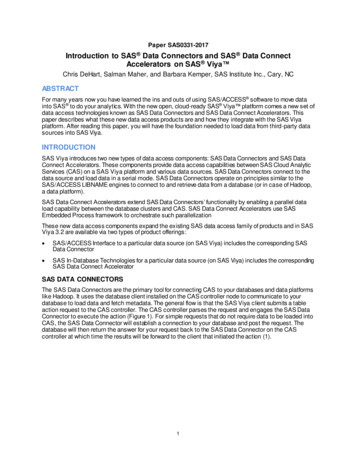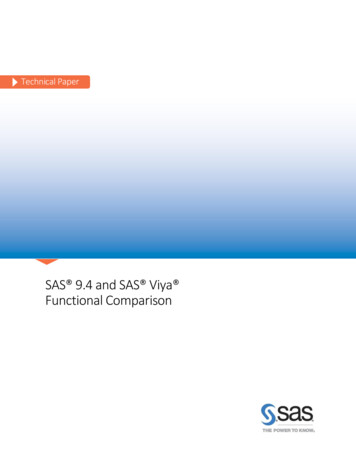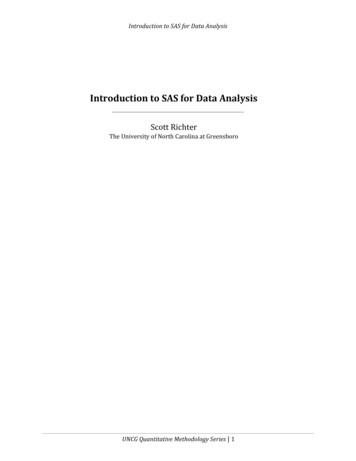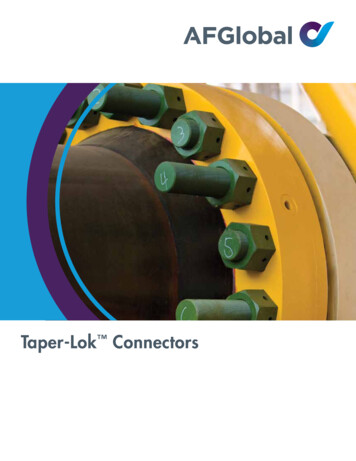
Transcription
Paper SAS0331-2017Introduction to SAS Data Connectors and SAS Data ConnectAccelerators on SAS Viya Chris DeHart, Salman Maher, and Barbara Kemper, SAS Institute Inc., Cary, NCABSTRACTFor many years now you have learned the ins and outs of using SAS/ACCESS software to move datainto SAS to do your analytics. With the new open, cloud-ready SAS Viya platform comes a new set ofdata access technologies known as SAS Data Connectors and SAS Data Connect Accelerators. Thispaper describes what these new data access products are and how they integrate with the SAS Viyaplatform. After reading this paper, you will have the foundation needed to load data from third-party datasources into SAS Viya.INTRODUCTIONSAS Viya introduces two new types of data access components: SAS Data Connectors and SAS DataConnect Accelerators. These components provide data access capabilities between SAS Cloud AnalyticServices (CAS) on a SAS Viya platform and various data sources. SAS Data Connectors connect to thedata source and load data in a serial mode. SAS Data Connectors operate on principles similar to theSAS/ACCESS LIBNAME engines to connect to and retrieve data from a database (or in case of Hadoop,a data platform).SAS Data Connect Accelerators extend SAS Data Connectors’ functionality by enabling a parallel dataload capability between the database clusters and CAS. SAS Data Connect Accelerators use SASEmbedded Process framework to orchestrate such parallelizationThese new data access components expand the existing SAS data access family of products and in SASViya 3.2 are available via two types of product offerings: SAS/ACCESS Interface to a particular data source (on SAS Viya) includes the corresponding SASData Connector SAS In-Database Technologies for a particular data source (on SAS Viya) includes the correspondingSAS Data Connect AcceleratorSAS DATA CONNECTORSThe SAS Data Connectors are the primary tool for connecting CAS to your databases and data platformslike Hadoop. It uses the database client installed on the CAS controller node to communicate to yourdatabase to load data and fetch metadata. The general flow is that the SAS Viya client submits a tableaction request to the CAS controller. The CAS controller parses the request and engages the SAS DataConnector to execute the action (Figure 1). For simple requests that do not require data to be loaded intoCAS, the SAS Data Connector will establish a connection to your database and post the request. Thedatabase will then return the answer for your request back to the SAS Data Connector on the CAScontroller at which time the results will be forward to the client that initiated the action (1).1
Figure 1 Data Flow for Serial Data TransferFor requests that require data to be loaded into a CAS table, the work flow is slightly different. In this casethe SAS Viya Client submits a table action request to the CAS controller like before and the SAS DataConnector then initiates a data transfer from your database to the CAS controller (1). Once the data landson the CAS controller it is redistributed to all the worker nodes in your CAS cluster (2). This load processis considered to be a serial load because the data is sent initial to the controller node before it isdistributed to all the work nodes.SAS DATA CONNECT ACCELERATORSThe SAS Data Connect Accelerators use the SAS Embedded Process to load a table from a data sourceinto a CAS table (Figure 2). The CAS controller node communicates with the SAS Embedded Processover a socket (1) and initiates the data transfer. The SAS Embedded Process then opens connections tothe CAS worker nodes (2) and transfers the table data directly to the worker nodes. The worker nodesadd the data to the CAS table. Because the data is sent directly to the worker nodes by the SASEmbedded Process, rather than routing all the data through the controller node for distribution to theworker nodes, the work is spread across multiple nodes and the data can be loaded from the data sourceinto CAS in parallel.2
Figure 2 Data Flow for Parallel Data TransferThe dataTransferMode option of the caslib statement determines whether the table will be loaded usingthe SAS Data Connector or the SAS Data Connect Accelerator. There are three possible settings for thedataTransferMode option -- "serial", "parallel", or "auto". Specifying dataTransferMode "serial" on yourcaslib will cause the table to be loaded using the SAS Data Connector. SpecifyingdataTransferMode "parallel" in your caslib statement will cause the table to be loaded using the SASData Connect Accelerator. If you specify a value of "auto", CAS will attempt to load the table using theSAS Data Connect Accelerator, but if the table load should fail for some reason, for example, if the SASEmbedded Process is not installed or has not been started on your data source cluster, then CAS willretry the table load using the SAS Data Connector. The default setting for dataTransferMode is "serial".When you load a table into CAS, you can override the dataTransferMode setting that was specified in thecaslib statement by specifying dataTransferMode in the DataSource options parameter of the load table./* creates new caslib for parallel execution*/caslib myTeraCaslib sessref mysessdatasource (srctype "teradata",server "myTeraServer",username "user",password *****,database "test",dataTransferMode "parallel");During a table load, you will see a "Note" level message indicating how the table is being loaded. Forparallel load the message is:NOTE: Performing parallel LoadTable action using SAS Data Connector Accelerator for Teradata.For serial load it is:NOTE: Performing serial LoadTable action using SAS Data Connector to Teradata.All SAS Data Connectors and SAS Data Connect Accelerators need to have appropriate database clientsinstalled and configured on the CAS controller node.3
SAS VIYA CLIENTSWith the release of SAS Viya, you are now able to work in a variety of client environments. The followingexamples will give you the basics on how to create a SAS Data Connector connection for the supportedclients.SAS ClientThe SAS client gives you two ways to define a SAS Data Connector. It is good time to note that a SASData Connector reference in SAS is now as a casLib. Caslibs are the mechanism for accessing datawithin CAS. They provide a fluid way to hold tables and data source information used by your CASsession.The two ways to define a casLib are with the CAS statement or with the CASLIB procedure (PROC CAS).Regardless of which method you choose to use, you need always need to specify the CAS server hostand create a CAS session first in your program.options cashost "myCASHost.sas.com";/* creates cas session */cas mysess;casLib StatementWhen using a caslib statement, you specify data connector parameters within the datasourceparameter. You will find that this is very similar to a LIBNAME statement with one of the SAS/ACCESSengines. One major difference is that the casLib statement does not try to connect to your data sourcewhen it is executed. The connection is deferred until the first database request is made by a CAS action./* creates new caslib */caslib pgLib sessref mysessdatasource (srctype "postgres",server "myPostgresServer",database "test",username "user",password "password");The name that you give to your casLib must be unique within the session you specified with the sessrefparameter on the caslib statement. If your casLib name is the same as a global caslib, the global caslib iseffectively hidden from use within your session.CAS Procedure (PROC CAS)For PROC CAS, you specify your data connector options within the datasource parameter for anaddCasLib action. The casLib name is specified by the lib parameter of the addCasLib action.proc cas;session mysess;action addCaslib lib "pgLib"datasource {srctype "postgres",server "myPostgresServer",database "test",username "user",password "password"};run;By default, the scope of your casLib is tied to your session. This allows the casLib that is defined withyour PROC CAS statement to be used by other procedures that reference as CAS session.4
Lua ClientTo use the SAS Lua Client Interface for Viya you need to have the SAS Scripting Wrapper for AnalyticsTransfer (SWAT) package for Lua installed. You can get the latest version from the support.sas.comdownload page. In addition, you need to be running a 64-bit Lua 5.2 or 5.3. Once you have SWATinstalled, you can import the SWAT package and create a connection to pull data via a data connector.-- Load the CAS objects for useswat require 'swat'-- Start a session in CAS (host, port, userid, password)s swat.CAS('myCASHost.sas.com', 5570,'user',’password’)-- Load the PostgreSQL Data Source objectr s:loadDatasource{name "postgres"}-- Define the PostgreSQL caslibr s:addCaslib{lib "pglib",datasource {srctype "postgres",server "myPostgresServer",database "test",username "user",password "password"}}Python ClientTo use the SAS Python Client Interface for Viya you need to have the SWAT package for Pythoninstalled. You can get the latest version from the support.sas.com download page or GitHub. In addition,you need to be running a 64-bit Python 2.7, 3.4, or 3.5 on Linux. Once you have SWAT installed, you canimport the SWAT package and create a connection to pull data via a data connector.-- Load the CAS objects for useimport swat-- Start a session in CAS (host, port, userid, password)conn swat.CAS('myCASHost.sas.com', 5570,'user',’password’)-- Load the PostgreSQL Data Source objectconn.loaddatasource(name "postgres")-- Define the PostgreSQL caslibconn.addcaslib(datasource sword'},lib 'pglib')Java ClientTo use the SAS Java Client Interface for Viya you need to have the cas-client jar on your java classpath.You can get the latest version of the cas-client jar from the support.sas.com download page. In additionyou need to be using a Java 8 runtime environment with ANTLR runtime (3.5.2) and Google ProtocolBuffers (2.6.1) setup on your classpath.There are two ways to define a casLib in Java. One is with the predefined data source options classesand the other is by using a general purpose java.util.HashMap.5
Using Predefined Data Source Option ClassesAll predefined, data source options classes are located in the com.sas.cas.actions package. Names startwith “D” and are followed by the source type name. For example, the data source class for PostgreSQL iscom.sas.cas.actions.Dspostgres. Note the data source type names are in all lowercase letters. Here is anexample.// Instantiate a new client. Set the host, port, username, and passwordCASClientInterface client new d");// Setup the data source options for PostgreSQL.Dspostgres dsPostgreSQL new rd");// Create the casLib reference to the PostgreSQL data sourceAddCaslibOptions addCasLibOptions new KEY DATASOURCE,dsPostgreSQL);// Add the PostgreSQL casLib to the CAS Server.CASActionResults CASValue results client.invoke(addCasLibOptions);Using General Purpose Option ClassesIf you do not want to use one of the predefined data source option classes or if you cannot find one for adata source that you know is supported by CAS, then you can define your data source using ajava.util.HashMap class. In this case, the key values for the hash map are the attributes that need to beset for your data source. Note that the srctype value most be set in when using a hash map.// Instantiate a new client. Set the host, port, user name, andpasswordCASClientInterface client new d");// Set up the datasource optionsMap String, Object dsPostgreSQL new HashMap String, Object ();dsPostgreSQL.put("srctype", "postgres");dsPostgreSQL.put("database", "test");dsPostgreSQL.put("server", "myPostgresServer");dsPostgreSQL.put("password", "password");dsPostgreSQL.put("username", "user");// Create the casLib reference to the PostgreSQL data sourceCASActionOptions addCasLibOptions ions.setParameter("lib","pgLib" );addCasLibOptions.setParameter("datasource", dsPostgreSQL);// Add the PostgreSQL casLib to the CAS ServerCASActionResults CASValue results client.invoke(addCasLibOptions);6
WORKING WITH CAS ACTIONSA CAS action is a task that is performed by the CAS server at your request. The server parses thearguments of the request and invokes the action function. Actions that can be used with SAS DataConnectors include loadTable, columnInfo, and fileInfo.LOADTABLE ACTIONThe loadTable action directs the server on your behalf to load a table from a specified caslib data sourceinto the CAS server. The action at a minimum takes a caslib parameter that describes the origin of yourtable to load, a path parameter that is the table name of your DBMS table to load, and a casoutparameter for specifying the setting for the output table. For example, if you had a table in yourPostgreSQL DBMS named "cars" that you want to load in CAS with the name “mycars”, you could use thefollowing loadTable statement:proc cas;session mysess;action loadTable / caslib "pgLib" path "cars" casout "mycars";quit;Subset Your ColumnsWith the loadTable action vars parameter, you can specify which columns are to be returned from yourloadTable action. This allows you to only bring back those columns that are needed for your analysis inCAS. For example, if you had a table in your DBMS named "cars" that contained the columns "make","model", "year", "color", and "units", but you were only interested in bringing in the "color" and "units"columns to analyze in CAS, you could use the following loadTable statement to subset on those columns:proc cas;session mysess;action loadTable / caslib "pgLib"path "cars"varlist {"color", "units"}casout "mycars";run;Filtering Your DataIf you want to filter the data before it is loaded into a CAS table, then use the data source dbmsWhereparameter. With the dbmsWhere parameter, you can specify your database WHERE clause to be passeddirectly to the target database without modification. For example, given the same "cars" table mentionedabove, you could use this code to subset on the "year" column just to read in all the cars built in 2016:proc cas;session mysess;action loadTable / caslib "pgLib"path "cars"datasource {dbmsWhere "year 2016"}casout "cars2016";run;It is a good time to note that using the WHERE option in a LOAD statement or using the where parameterfor a loadTable action will result in an error. You must use the dbmsWhere option if you want to pass aWHERE clause to the DBMS through the data connector.7
COLUMNINFO ACTIONThe columnInfo action can be used to obtain metadata information about the columns in your DBMStables. The action takes a table parameter that describes the casLib and the table name of your DBMStable. The following example gets the column information for the “cars” table:proc cas;session mysess;action columnInfo / table {caslib "pgLib" name "cars"};run;Below is the output from this example call to columnInfo.Output 1 Results from table.columnInfoThis is a good time to talk about scoping with the columnInfo action. If a DBMS table has not been loadedinto CAS and you call columnInfo with the DBMS table name, the column metadata that you receive is theDBMS view of the table. However, if you call a loadTable action and load that DBMS table into the samecasLib and then call columnInfo, you will receive the column metadata from the loaded CAS table, NOTthe DBMS table. For this reason, a best practice is to load your DBMS tables into a different casLib fromyour DBMS casLib by specifying a user casLib in the casout parameter of loadTable.FILEINFO ACTIONThe fileInfo action provides a list of tables and views that are accessible with a specified caslib datasource. The action takes a caslib parameter that describes the casLib you want to get the list of tablesand views from. For example, this is the PROC CAS call to get the list of table from the pgLib caslibdefined above:proc cas;session mysess;action fileInfo / caslib "pgLib";quit;Below is the output from this example call to fileInfo.8
Output 2 Results from table.fileInfoSearch Patterns in the fileInfo ActionYou can limit the results of the fileInfo action by using wildcard characters to filter by filename. The fileInfopath argument accepts a search pattern as part of the path. The search pattern is used when the fileInfooption wildignore is set to FALSE. Using a pattern limits the results returned to the files that match thepattern. By default search patterns are enabled.The search pattern characters are: Percent sign (%), which represents any sequence of zero or more characters Underscore ( ), which represents any single character Backslash (\), which acts as an escape character, used to include underscores, percent signs,and the escape character as literalsSearch Patterncwd%%cwd%cwdDescriptionMatches any table name beginning with "cwd"Matches any table name containing “cwd”Matches any 4-character table name that beginswith "cwd"cwd\ %‘%cwd’Matches any table beginning with “cwd ”Use single quotation marks prevent SAS frominterpreting %cwd as a SAS macro nameTable 1 Search PatternsHere is PROC CAS code for the pgLib example above expanded to return only tables that begin with“AS ”:proc cas;session mysess;action fileInfo / caslib "pgLib" path ’AS\ %’;quit;Below is the output from this example:9
Output 3 Results from table.fileInfoBy default, matching is case-sensitive. The ‘AS\ %’ pattern does not match tables that begin with alowercase ‘as ’. You can enable a case-insensitive search by setting the wildsensitive parameter to false.OPTIONS FOR CAS ACTIONSSPECIFYING OPTIONSOptions for CAS actions are called parameters, and these parameters function much like the LIBNAMEand data set options in SAS/ACCESS LIBNAME engines. For most of the actions the DBMS-specificparameters for the SAS Data Connectors are specified through an “options” container parameter. Thisexample shows how to pass a specific schema name into your fileInfo action call to only bring back thoseDBMS tables that exist in a particular DBMS schema.proc cas;session mysess;action fileInfo / caslib "pgLib" options {schema ”public”};quit;The exception to the “options” container parameter in actions is the addCaslib action, where all theDBMS-specific options are specified inside the datasource parameter container.OVERRIDING OPTIONSUnlike SAS/ACCESS options, SAS Data Connector parameters are strictly hierarchical in nature. Thismeans that all the parameters are defined at the top level, which in our case means the caslib level. Anyaction that uses the caslib can override those parameters at the action level. For example, you coulddefine a top-level schema for your database connection at the caslib level with the following addCaslibaction:proc cas;session mysess;action addCaslib lib "pgLib"datasource {srctype "postgres",server "myPostgresServer",database "test",username "user",password "password"schema "public"};run;This means that any action that uses the “pgLib” caslib would automatically use the “public” schema forthe database. If you wanted to, for example, look at the column information in another schema during thatsame PROC CAS session, you could simply override the “schema” parameter in the columnInfo action:action columnInfo / table {caslib "pgLib" name "cars"}options {schema "test"};10
This columnInfo would then show column metadata for a table “cars” in the “test” schema instead of the“public” schema.LOGGINGThe primary logging method used by the SAS Data Connectors is the SAS lo
SAS/ACCESS LIBNAME engines to connect to and retrieve data from a database (or in case of Hadoop, a data platform). SAS Data Connect Accelerators extend SAS Data Connectors’ functionality by enabling a parallel data . CAS











